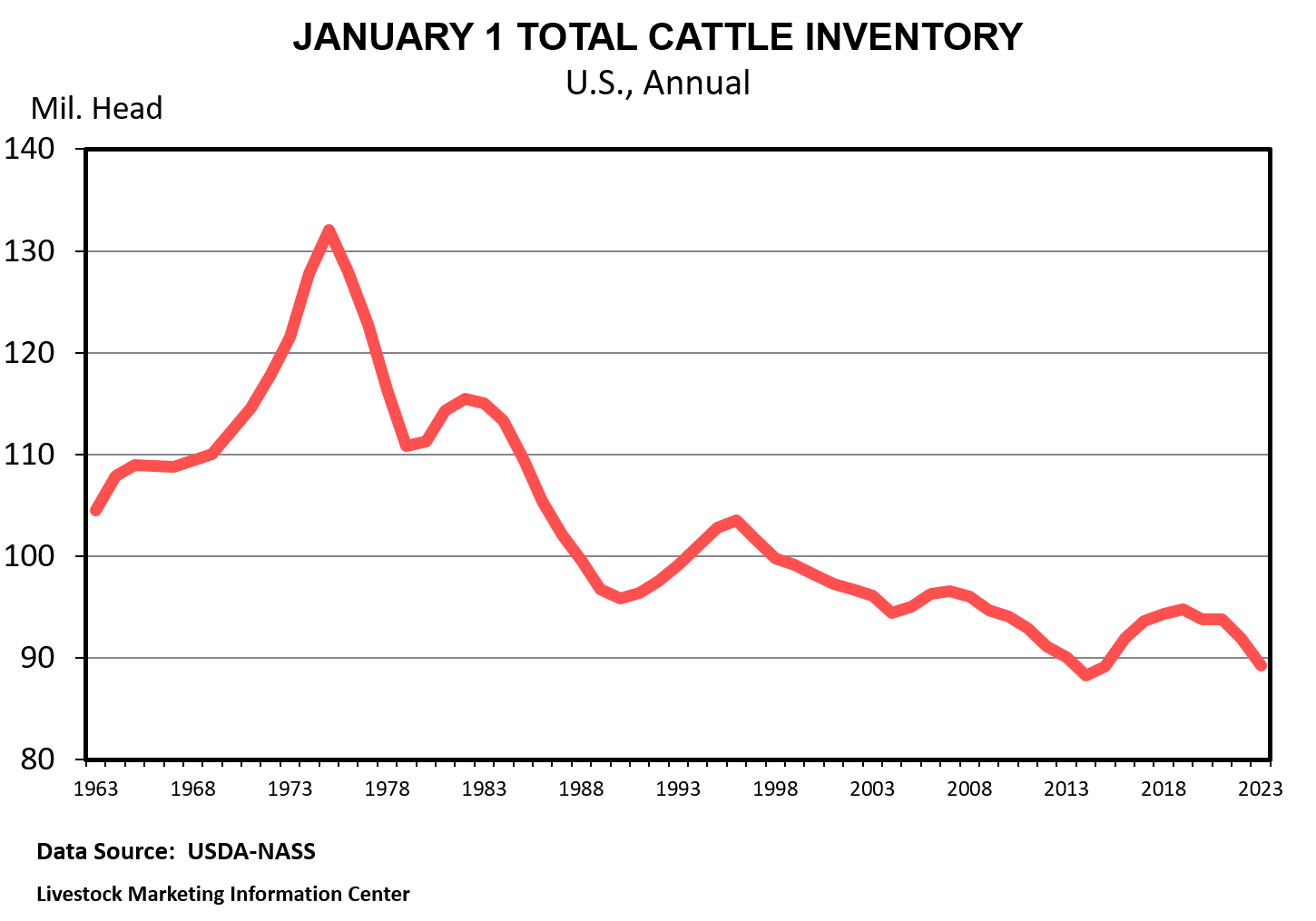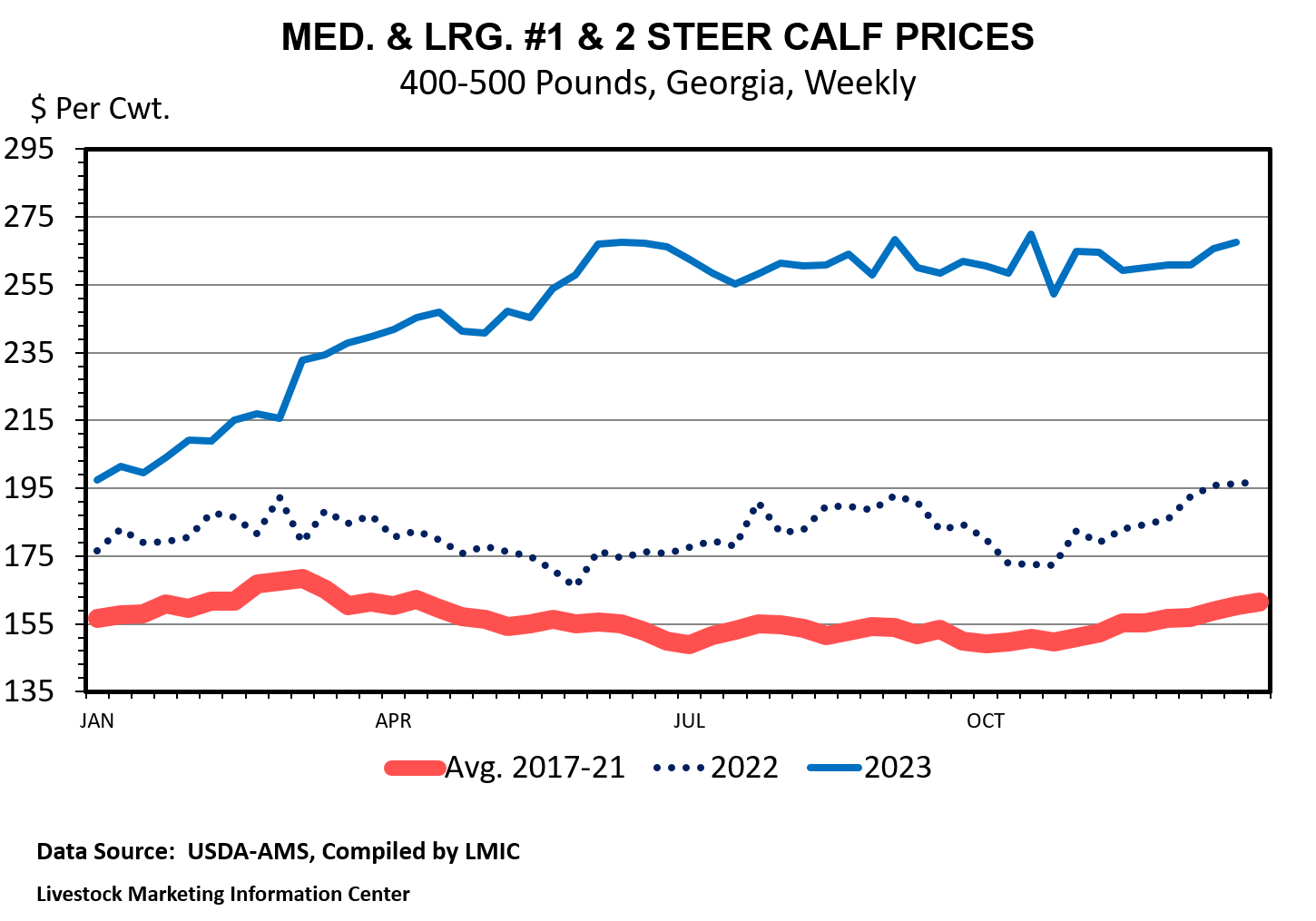Main Takeaways
- The beef cattle outlook is positive in 2024. Tight supplies and stable consumer demand are expected to push cattle prices higher in the year ahead.
- Risks to the outlook come from the demand side in the form of U.S. consumers uninterested or unable to continue to pay for higher-priced beef. Additionally, input cost uncertainty may squeeze margins.
- Overall, beef cattle prices are expected to move higher year-over-year throughout 2024.
2024 Beef Cattle Outlook
The beef cattle market outlook is strong for 2024. Beef cattle markets marched higher in 2023 with prices reaching record highs. Since then, prices moderated in line with seasonal trends but remain well above prices in 2022. The higher prices are the result of tight supplies and a resilient U.S. beef consumer. These market fundamentals are expected to persist into 2024, while demand-side risks may limit how high prices may go.
As calendars turned to 2023, the U.S. cattle industry ended a year of tremendous production and significant cattle herd reduction (Figure 1). The highest number of beef cows in a 25-year period were slaughtered in 2022 because of a significant drought in the Plains. In 2023, cattle slaughter slowed slightly but remained elevated through the first half of the year. In the second half, beef production slowed. Throughout the year, U.S. consumers continued to consume beef amid record-high retail beef prices, with the U.S. Department of Agriculture reporting in November a 10% year-over-year increase in all-fresh beef retail value. High prices were seen across the beef cattle supply chain with extremely high fed and feeder cattle prices seen through the summer. The 5-Area average steer price in June was about $180/cwt, and the average June price for a 400–500 lb feeder steer in Georgia was around $267/cwt (Figure 2). Feeder cattle prices fell in line with seasonal patterns in the fall, but prices remained robust in Georgia.

From USDA NASS Livestock Marketing Information Center.

From USDA NASS Livestock Marketing Information Center.
Indications are that next year will see similarly high or higher prices as beef cattle inventories are expected to continue to decline, while the U.S. beef consumer appears to be strong financially and continues to buy beef. Uncertainty in this forecast comes from potential risks to the financial health of U.S. consumers and the timing of the cattle herd rebuild. Forage availability and input cost uncertainty are also risks that may impact the profitability of Georgia’s beef cattle industry. If forage is less available, hay prices may increase and prevent herd expansion. Similarly, higher input costs could dampen interest in growing herds.
Retail beef prices were higher in the summer of 2023. Price increases had a broad base with prices increasing for steaks and ground beef alike. Premiums for Choice over Select were high compared to last year through the summer with recent data suggesting they are similar to 2022. Lastly, retail outlets had fewer beef specials and featured beef at similar rates compared to 2022, indicating that retailers do not need to highlight beef to make sales. This suggests the U.S. consumer desires high-quality beef despite high prices.
Beef production is firmly in the hands of the cattle cycle. This is a regular pattern in cattle inventory that spans about 10 years from one trough in cattle numbers to the next. We are now entering year 10. The beef cattle herd in the U.S. is expected to drop again in 2024. However, a low in cattle inventory is not expected until the latter half of 2024, or more likely in 2025. While margins have improved in 2023, profits have not reached levels that incentivize significant herd rebuilding efforts. Prices will respond to changes in supplies at different stages of the supply chain as we saw at the end of 2023 with unexpectedly high placements into feedlots. However, these are more driven by timing than underlying market fundamentals of more cattle. Overall cattle prices should be trending higher in the year ahead.
U.S. beef consumers will be tested in the coming year as supplies tighten further. If consumers continue to buy beef at even higher prices, fed cattle and calf prices can continue to move higher. However, if consumers start to hesitate or pull back, cattle prices may see more resistance as they try to move higher. This is the main risk to the beef cattle industry in the year ahead as supplies are poised to remain limited.
Input costs also pose risks in the year ahead. Pasture and range conditions significantly improved for much of the U.S. in 2023, and there are no signs that this will change in 2024. As a result, hay prices in much of the country are coming down. However, the Southeast saw pasture conditions deteriorate later in the summer and through the fall. If this trend continues, cow-calf producers may see margins shrink as supplemental feeding may be warranted. Other input costs may also compress margins. While fertilizer prices have plummeted from the highs seen in the summer of 2022, other costs such as fuel and interest rates remain elevated.
Smaller supplies year-over-year and consistent consumer demand means prices should increase all along the beef cattle supply chain. Additionally, input costs should be similar to last year. Risks arise most significantly from end-consumers’ financial health and willingness to continue to purchase high-priced beef. Overall, cow-calf margins should be very strong in the year ahead.
Status and Revision History
In Review on Jan 19, 2024
Published on Jan 22, 2024


























































